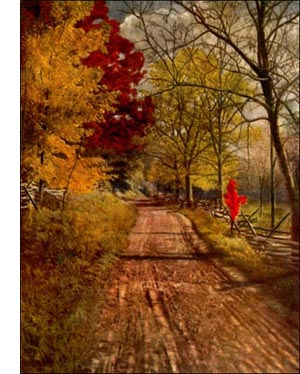Dotted Haw Tree
 Dotted Haw (Crataegus punctata, Jacq.)-A broad, roundheaded tree, 20 to 30 feet high, with horizontal branches, and rigid twigs. Thorns straight, slim, 2 to 3 inches long, brown or grey. Bark thin, dark brownish red, in long, plate-like scales, branches brown to pale grey; twigs pubescent at first, soon becoming smooth. Wood red-brown, hard, close-textured.
Dotted Haw (Crataegus punctata, Jacq.)-A broad, roundheaded tree, 20 to 30 feet high, with horizontal branches, and rigid twigs. Thorns straight, slim, 2 to 3 inches long, brown or grey. Bark thin, dark brownish red, in long, plate-like scales, branches brown to pale grey; twigs pubescent at first, soon becoming smooth. Wood red-brown, hard, close-textured. Buds plump, small, scaly, shiny. Leaves obovate, acute or obtuse at apex, 2 to 3 inches long, narrowed to short petiole; sharply serrate, sometimes lobed, entire toward base; pubescent at first, smooth at maturity, except on veins below, leathery, grey-green, orange and scarlet in autumn. Veins prominent, depressed above.
Flowers, May, when leaves are half grown, in thick, flat, many-flowered corymbs on pale tomentose stems; calyx hairy, corollas spreading, white, 1/2 to 3/4 inch across, stamens 20, with rose-coloured or yellow anthers, styles 2 to S, hairy at base. Fruit falls in October, short-oblong to sub-globose, 1/2 to 1 inch long, yellow or red; marked by white dots; flesh thin, dry; calyx lobes flattened; nutlets 5, ridged on back.
Preferred habitat, rich, moist upland soil. Farm thickets. Distribution, Quebec to Detroit; western New England, along mountains to northern Georgia, Tennessee and North Carolina; west to Ohio and Illinois. Uses: Valuable ornamental hawthorn.
The large, pale dots on the fruit of this haw give it its name, punctata. Very strangely, some trees produce yellow fruit, and have flowers with yellow anthers; while red is the rule in both anthers and fruit.
The dotted haw is a handsome, long-thorned tree, with obovate, strongly veined leaves, whose colour in autumn is like fire. The fruit is brilliant, too, hanging in full clusters long after the leaves drop.
Crataegus collina, Chapm., which resembles C. punctata and C. Crus-galli in habit, has yellow-green foliage, and the dull red fruits are flattened globes, containing five grooved and ridged nutlets. Sometimes the branches are set with formidable, branched thorns, 6 inches long. It is quite common for the trunk to be corrugated and buttressed at the base.
This tree grows along the foothills from West Virginia to central Georgia, and west half way across Tennessee and Alabama. It reaches an altitude of 2,500 feet. It is an early species, blooming in April when the leaves are scarcely opening, and ripening its fruit in September. The flesh is yellow and thin, mealy and insipid.